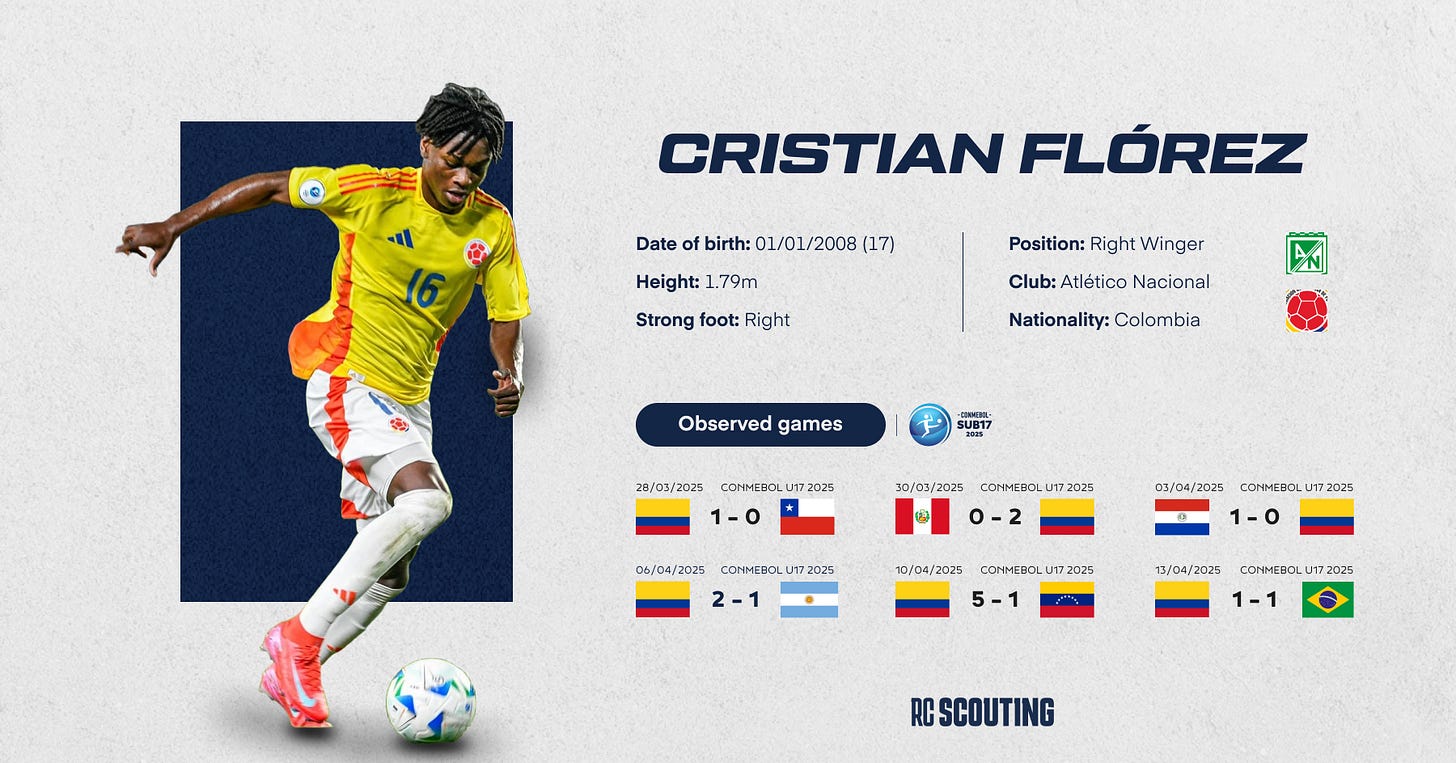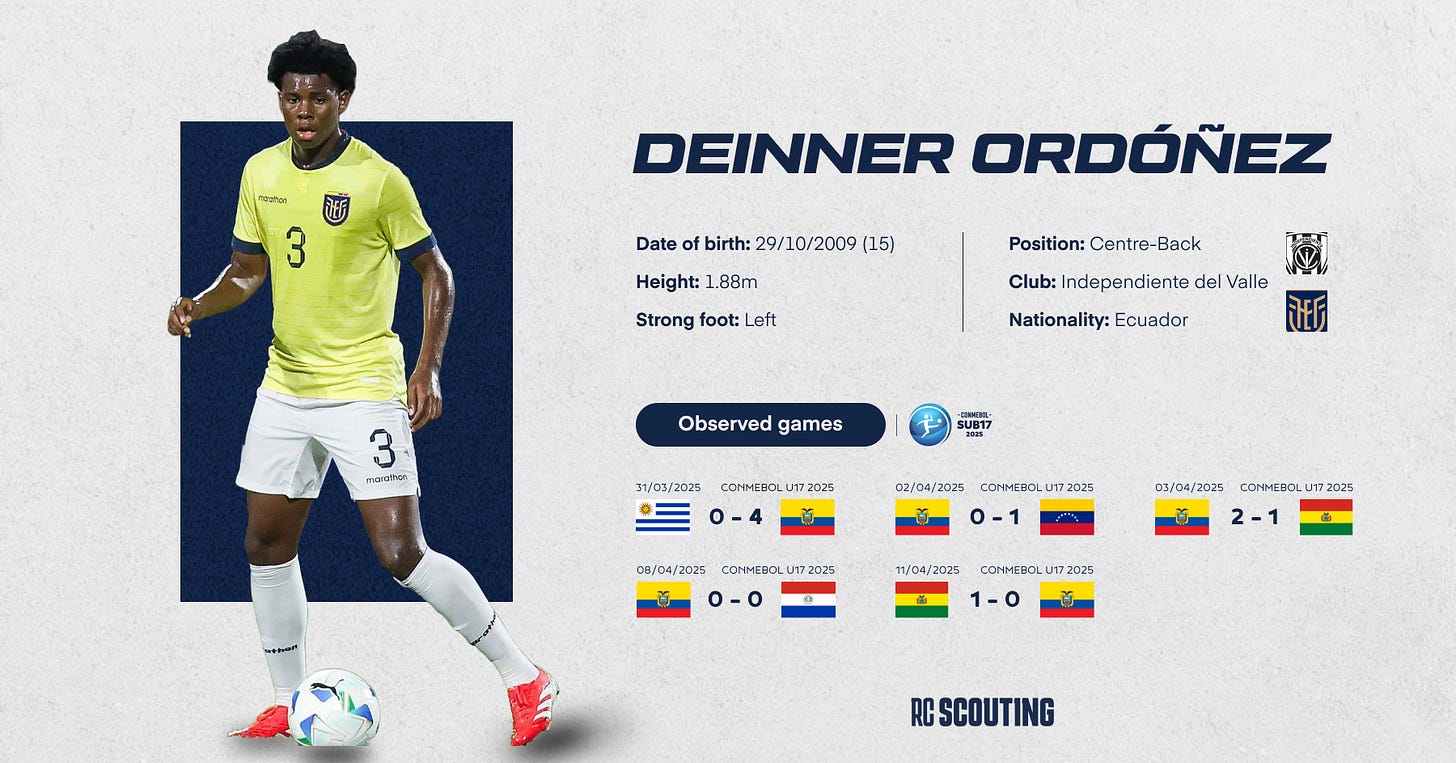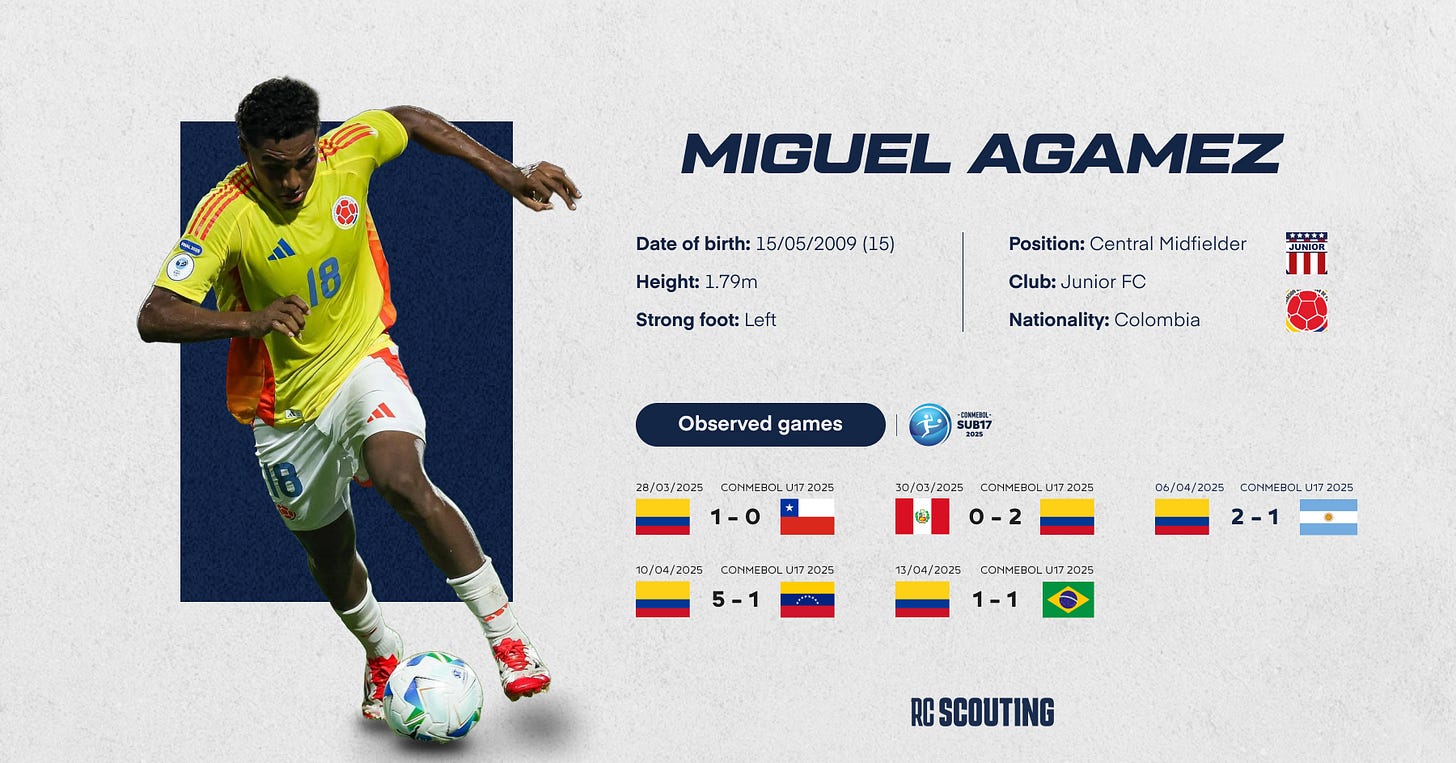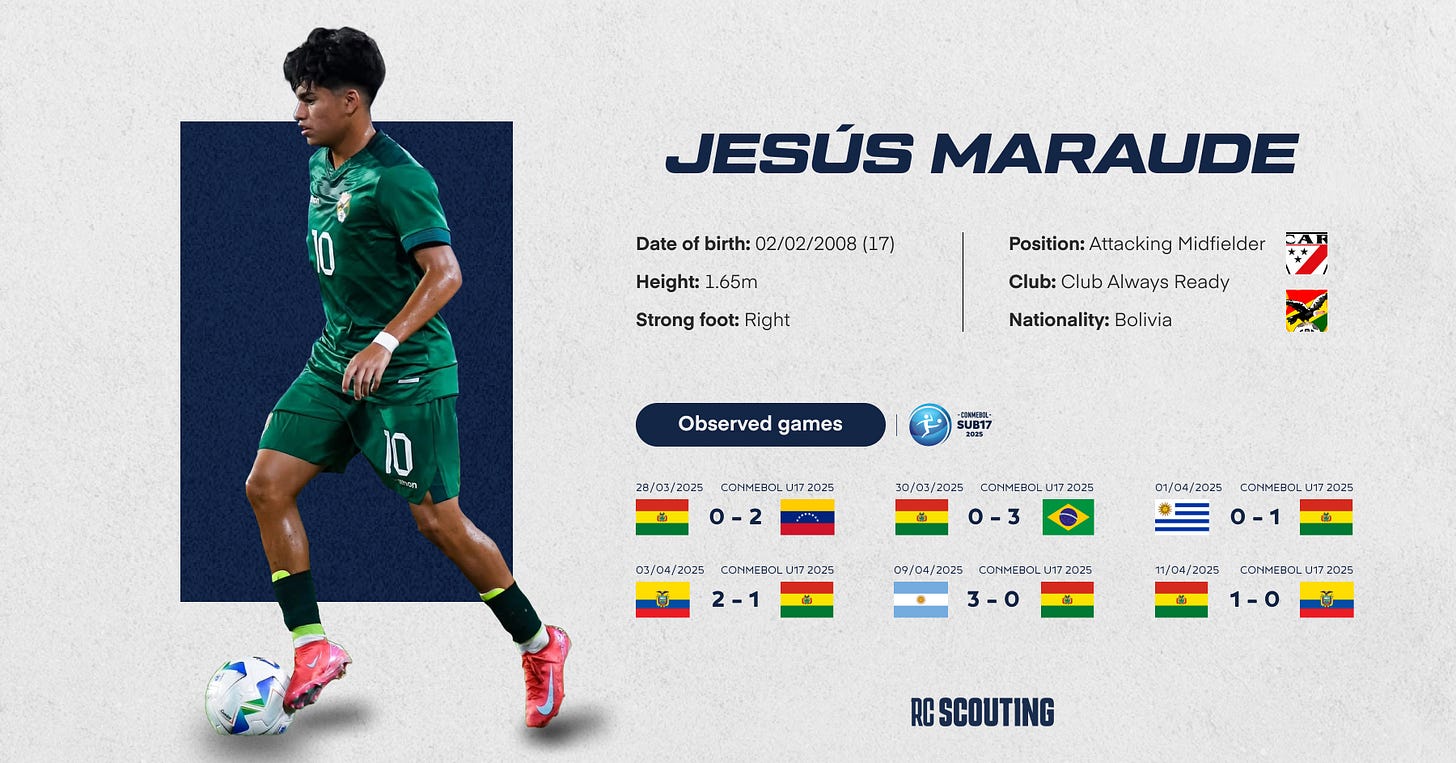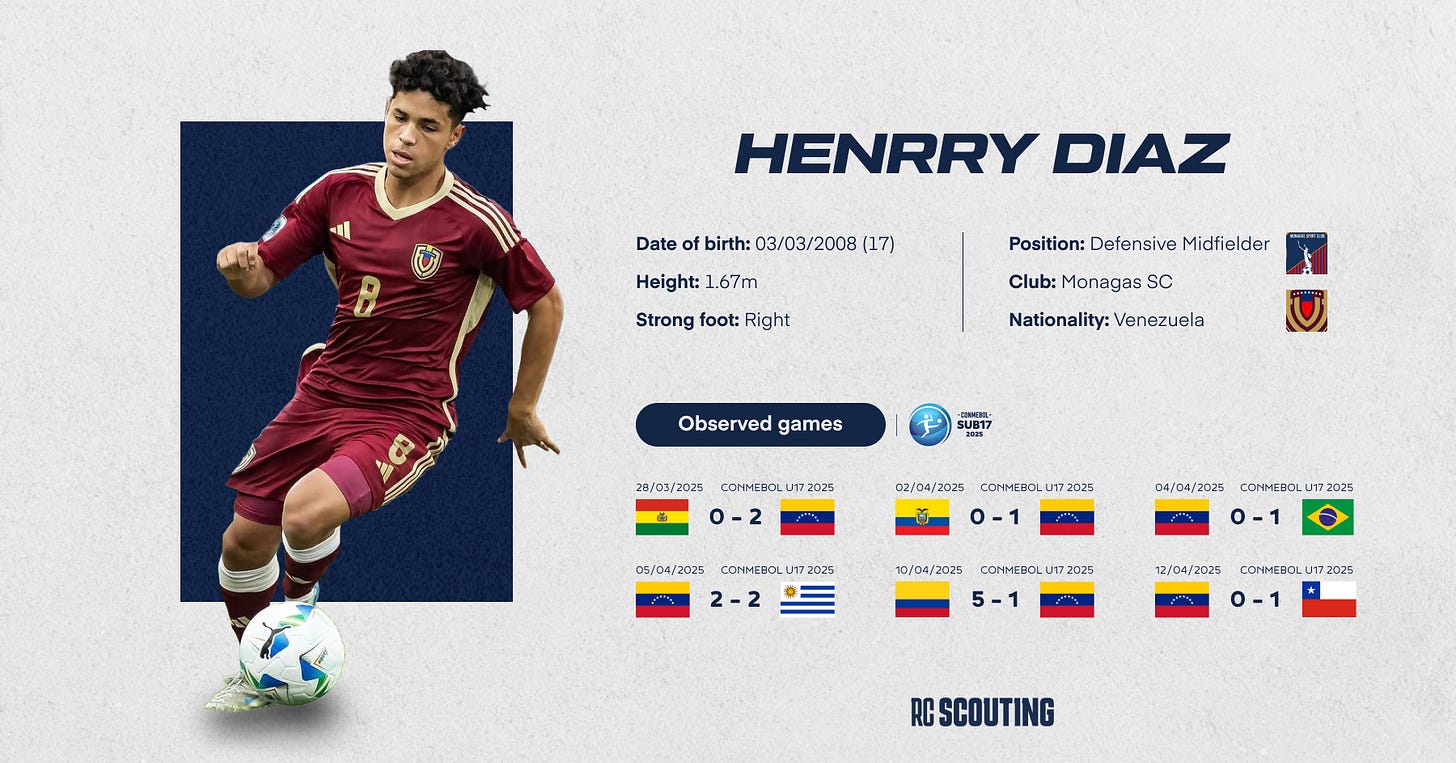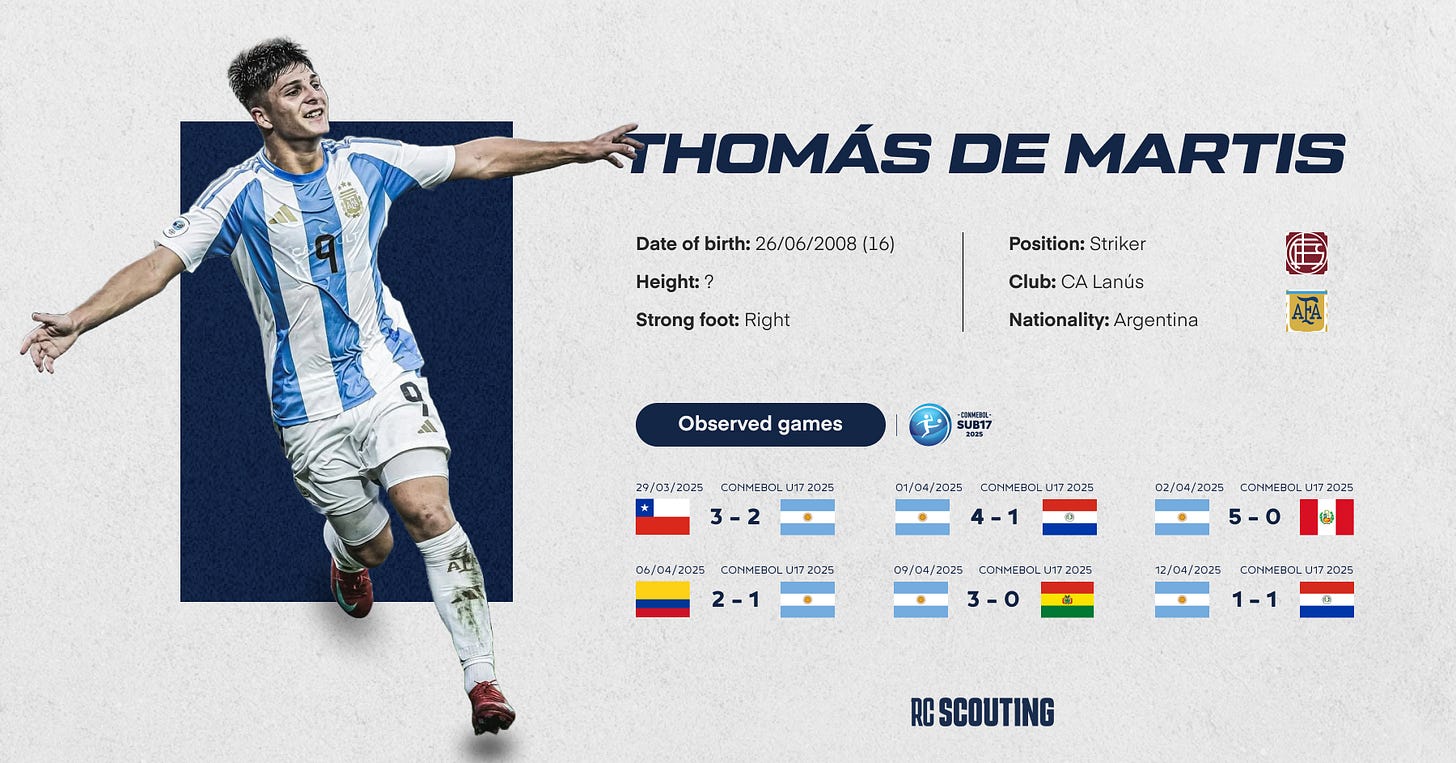10 Standouts from the 2025 U-17 CONMEBOL
A closer look at the next generation coming out of South America.
The 2025 U-17 CONMEBOL tournament recently came to an end, and as is often the case at this level, it offered a valuable glimpse into the next generation of South American talent. Across 28 games, I took the time to observe different dynamics, playing styles, and individual tendencies that start to emerge at this stage of development.
Going into the tournament, I had very little knowledge of the players involved. I don’t usually follow South American football closely, so this was a fresh opportunity to discover new profiles from scratch and I’m glad I did. Some players genuinely impressed me, not just because of standout moments, but because of specific traits that caught my attention. I’ll definitely keep a closer eye on youth football from this region moving forward.
In this piece, I’ve highlighted ten players who caught my eye. They’re not necessarily the ten best performers of the tournament, but rather profiles I found particularly interesting for a variety of reasons. Some only played limited minutes, others were more prominent, but all had something in their game that made me want to take note. These are early impressions, of course, but they already offer a few clues on players to follow heading into the U-17 World Cup next November 👀
🇨🇴 Cristian Flórez (2008/RW/Atlético Nacional)
Among all the players I followed during this tournament, Cristian Flórez was the one who stood out the most to me. His athletic profile was a key part of that impression, and it makes him a particularly exciting prospect.
He operates primarily as a traditional right winger, relying on pace and dribbling to stretch the play and create opportunities from wide areas. He’s a player who doesn’t hesitate to take on his marker, often using sudden changes of pace to gain the upper hand – a quick burst, a slight deceleration, followed by an explosive restart. On several occasions, he managed to break free down the flank and create crossing situations. However, the execution in the final third still needs improvement. His crosses often feel rushed, hit more in hope than with real purpose. If he can improve his ability to pick out teammates in those moments, his offensive impact could reach another level.
From a technical standpoint, the early stages of the tournament revealed some inconsistencies, particularly in his ball-carrying requiring constant readjustments and sometimes leading to turnovers. That said, he seemed to grow into the tournament and showed much more control in later games. His ability to use both feet in tight situations also stood out as a valuable asset.
Physically, he’s already quite advanced. He’s listed at 1.79m for 73kg, with a slender frame and long legs. His acceleration and top-end speed, both over short and long distances, are impressive and his vertical leap is remarkable, especially considering how explosive it is even without a run-up. With more work on his aerial timing, he could even become a real threat in attacking headers. That said, he can still be knocked off balance when playing with his back to goal or during shoulder-to-shoulder duels at full speed. I believe using more his arms during these duels and adding some upper and lower body strength, through a tailored physical programme, could really elevate his game.
What I also appreciated is his commitment on the defensive side. He tracks back well, reads the game intelligently, and uses his reach effectively to win the ball back through timely interceptions and tackles. His work in transition helped Colombia on multiple occasions.
🇧🇴 Thiago Castedo (2008/CM/Club Bolívar)
Despite playing just 115 minutes across the tournament, including only one start against Venezuela, Thiago Castedo show great qualities to earn a place in this article.
A left-footed central midfielder, he is clearly attack-minded in his tendencies. He stands at 1.66m for 62kg, and his low center of gravity serves him well, particularly when receiving with his back to goal. His ability to handle pressure in tight areas is made possible by sharp, well-executed oriented controls and a clear desire to play forward quickly.
Technically, I was impressed by the quality of his passing. Whether short or long, his passes were consistently well-weighted and often helped accelerate the play. Off the ball, he showed constant movement and was always looking to be involved, often occupying pockets of space between the lines. Physically, while he doesn’t impose himself through power, he managed duels smartly, using his body positioning and quick footwork to stay ahead of opponents and draw fouls.
Even though his playing time was limited, I was genuinely surprised not to see more of him as the tournament progressed. His ability to add fluidity and coherent verticality to his team’s midfield play made a strong impression in the minutes he had.
🇪🇨 Deinner Ordóñez (2009/CB/Independiente del Valle)
Among all the centre-backs at this tournament, few looked as physically imposing as Deinner Ordoñez. At just 15 years old, the Ecuadorian left-footer already stands at 1.88m for 74kg, a frame that naturally draws attention, but also comes with the usual challenges for players still learning to fully manage their body.
Positioned as the left-sided centre-back, he showed interesting composure in possession. He displayed solid technique on short passes, with both feet, but could refine his game under pressure. He was particularly effective breaking lines with grounded passes, much more so than with long aerial balls, which often lacked precision. That being said, his short-to-mid range distribution was clean and purposeful.
Physically, it’s clear that he’s still adapting to his growing body. His speed on the first few meters and over longer distances remains average, especially when facing explosive or quick attackers. There were also some visible limitations in his trunk mobility, particularly in body rotations and changes of direction, again, fairly expected at his age and size. On the positive side, he defended aerial situations well thanks to solid timing and positioning, and showed good judgment in slide tackles, where he was both committed and clean.
Overall, he already carries strong foundations and tools for the role. With natural physical development and more high-level experience, he’ll be an interesting player to follow in the coming years.
🇨🇴 Miguel Agamez (2009/CM/Junior FC)
Lined up as a left-sided central midfielder but often covering a wide zone due to his high work rate, Miguel Agamez was one of the most well-rounded midfielders I observed during the tournament. At 1.79m and 77kg, he already has a strong frame for a 15-year-old, and he uses it well on both sides of the ball. His profile throughout the competition was closer to a box-to-box midfielder, active in both recovery and attacking support.
Defensively, he doesn’t shy away from effort. He was regularly seen pressing, covering space, and engaging in ball recoveries. In possession, his game is simple and effective. He tends to favor one-touch passes and quick combinations, often looking to progress play through either short link-ups or longer aerial switches, particularly toward the right flank, where Cristian Flórez’s speed was an ideal target for his left-footed diagonals.
He also showed a strong ability to strike from the edge of the box. His shooting technique is quite powerful, and although his finishing still needs polishing, he already poses a genuine threat when given space around the area. With some refinement, especially in shot placement, he could become a regular direct threat in the final third.
🇧🇴 Jesús Maraude (2008/AM/Club Always Ready)
An attacking midfielder by name, but very often positioned wide on the left to cut inside onto his stronger right foot, Jesús Maraude is one of those players who immediately catch the eye with the ball at their feet. Standing at 1.65m and weighing 59kg, he’s small in size but benefits from a low center of gravity and well-balanced frame, which make him extremely comfortable when driving the ball forward.
His ball mastery is one of the most impressive in the tournament. Whether at full speed, in tighter spaces, or during 1v1 situations, his ball-carrying ability stands out. He’s a confident dribbler and someone who clearly enjoys hurting defenders, both through quick changes of direction and burst acceleration. He’s also not shy in front of goal, regularly taking shots from outside the box. While this does reflect his confidence, many of those attempts ended up off target, suggesting that his shot selection and finishing consistency still need refining.
Despite his offensive tendencies, Maraude also shows interesting commitment on the defensive end. He’s active in pressing and ball recoveries, helping his team in transitional moments. The most frustrating aspect of his game right now is that, while he has the vision and technical tools to be a creative hub, he hasn’t quite established himself yet as a true playmaker. There’s definitely a sense that he can become more efficient in the final third by refining his decision-making and timing.
At 17, there’s every reason to be patient. Maraude has enough raw quality to keep believing in his upside, and I’m already looking forward to seeing how he performs on the bigger stage at the next U-17 World Cup.
🇪🇨 Justin Lerma (2008/LW/Independiente del Valle)
Justin Lerma is a right-footed left winger, mostly used as an inverted wide player in this tournament. Standing at 1.76m for 70kg, his frame is relatively slender, but he moves with excellent coordination and agility. It was my first time watching him, but some of the qualities he showed suggest that he could have had a far more impactful tournament.
Technically, he’s very sound. He’s particularly strong in his first touch and close control even in crowded areas, he manages to stay composed, keeping the ball tight and making it extremely difficult for defenders to strip him of possession. When carrying the ball, he operates with a certain flow: he glides with short, calculated touches, and his change of pace is effective in throwing off defenders. In 1v1 situations, he can be a nightmare. His dribbling style is full of deception: stuttering runs, multiple short steps, quick body feints, sharp direction changes, all executed with great balance and ankle flexibility. He thrives in those moments where he needs to isolate a defender and find a sliver of space.
When he receives the ball in the left half-space close to the box, his body orientation and awareness allow him to attack the goal with composure. He also showed flashes of smart passing vision, especially in diagonals meant to switch play and stretch the block horizontally.
Despite his qualities, he wasn’t consistently influential across the games, still, he has clear ball progression value, unpredictable 1v1 ability, and sharp technical instincts. Pretty sad that Ecuador did not qualify to the U-17 World Cup, would’ve loved seeing him there.
🇻🇪 Henrry Diaz (2008/DM/Monagas SC)
At first glance, Henrry Diaz’s profile doesn’t scream "midfield anchor." Standing at just 1.67m for 65kg, he doesn't have the long levers or physical dominance typically associated with a defensive midfielder. Yet, across the tournament, Díaz consistently impressed through his positional intelligence, anticipation, and sharp reading of the game.
His defensive contributions came not from raw strength, but from his ability to break up play through well-timed interventions and smart positioning. He was often in the right place to intercept passes or slow down opposition transitions, not by chasing, but by reading the next move before it happened. That cerebral edge made him a reliable ball-winner despite the physical mismatch he occasionally faced.
With the ball, Díaz displayed a solid ability to keep possession ticking. His passes were usually simple but accurate, well-weighted, and purposeful, helping his team maintain rhythm in midfield. His vision allows him to play forward quickly when the opportunity arises, although there’s still room for improvement on his aerial balls into the box, which tended to be poorly calibrated.
What stood out most about Díaz was the composure he exudes. He’s calm under pressure, knows how to use his low center of gravity, solid lower body strength to stay on his feet in tight spaces, and has the technical base to work his way out of trouble. He might not turn heads immediately with flashy plays, but he's the type of player who brings balance and control to a midfield.
🇦🇷 Felipe Pujol (2008/CM/CA Vélez Sarsfield)
Another small-statured midfielder, Felipe Pujol (who mostly featured in a double pivot) brought a composed, technical presence to the right side of midfield. Though not physically imposing, his ability to carry the ball and play under pressure made him a reliable outlet in tight areas, particularly in the right half-space, where he often received, turned, and drove forward with intent.
One of his most notable traits was how comfortable he looked when accelerating play through the middle. His ball-carrying ability helped him break lines, especially during fast transitions, and he complemented this with clean short passing to maintain tempo and keep his team moving forward. His use of quick, purposeful touches and subtle feints creating pockets to exploit made him particularly difficult to contain in tight spaces.
He wasn’t a high-risk player in his own third. He preferred to keep it simple, choosing security over adventure when defending deep or under pressure. He also showed strong awareness in his positioning and communication, often using gestures to give positional cues or guide teammates around him.
🇨🇱 Yastin Cuevas (2008/ST/CSD Colo-Colo)
Yastin Cuevas is a right-footed striker who was often deployed on the right side of a 3-4-3 during the tournament. What stood out to me was his composure and confidence when playing with his back to goal. He showed strong fundamentals in hold-up play, using his body well to protect the ball and wait for support, often keeping things simple in possession.
While he isn’t the most explosive player and lacks real burst in behind, he compensates by embracing physical duels and using his solid lower body strength to hold his ground. Cuevas is not the cleanest technically, there were a few loose touches and imprecise through balls but he competes well and knows how to use his strengths. Despite being played out wide, I think his game would translate better in a more central role, either as a pivot or link-up striker where he can make the most of his hold-up qualities.
🇦🇷 Thomás De Martis (2008/ST/CA Lanús)
Thomas De Martis is a right-footed striker whose game revolves around smart positioning and timing more than flashy actions or high involvement in build-up. What stood out during the tournament was his ability to operate in the shadows, often drifting off the shoulder of defenders, subtly adjusting his runs to stay onside while remaining unmarked. He’s not the tallest forward, but he’s still quite competent in aerial duels. His sense of timing and body orientation allows him to be effective in two key areas: holding the ball with chest or head under pressure, and attacking the ball in the air inside the box, especially at the near post.
His movement in the box is worth noting. Rather than constantly demanding the ball, he waits for the right moment to spring into action, often exploiting gaps created by teammates or defensive disorganisation. He tends to strike when defenders are at their most vulnerable, either on the back foot or distracted by another threat. This element of surprise, combined with an explosive first few steps, makes him dangerous in transition or when attacking low crosses.
He doesn’t participate much in the build-up, but he isn’t clumsy when involved. He keeps it simple, offering short lay-offs or one-touch combinations. He’s not a volume shooter either — his finishing tends to be calculated, and he makes the most of limited touches inside the area. While not a physically dominant striker, he uses his lower-body strength and balance to hold off challenges, especially when receiving with his back to goal.
And… that’s it! Thanks for reading all the way through, I hope you enjoyed this piece. If you haven’t already, make sure to subscribe, it’s free!







